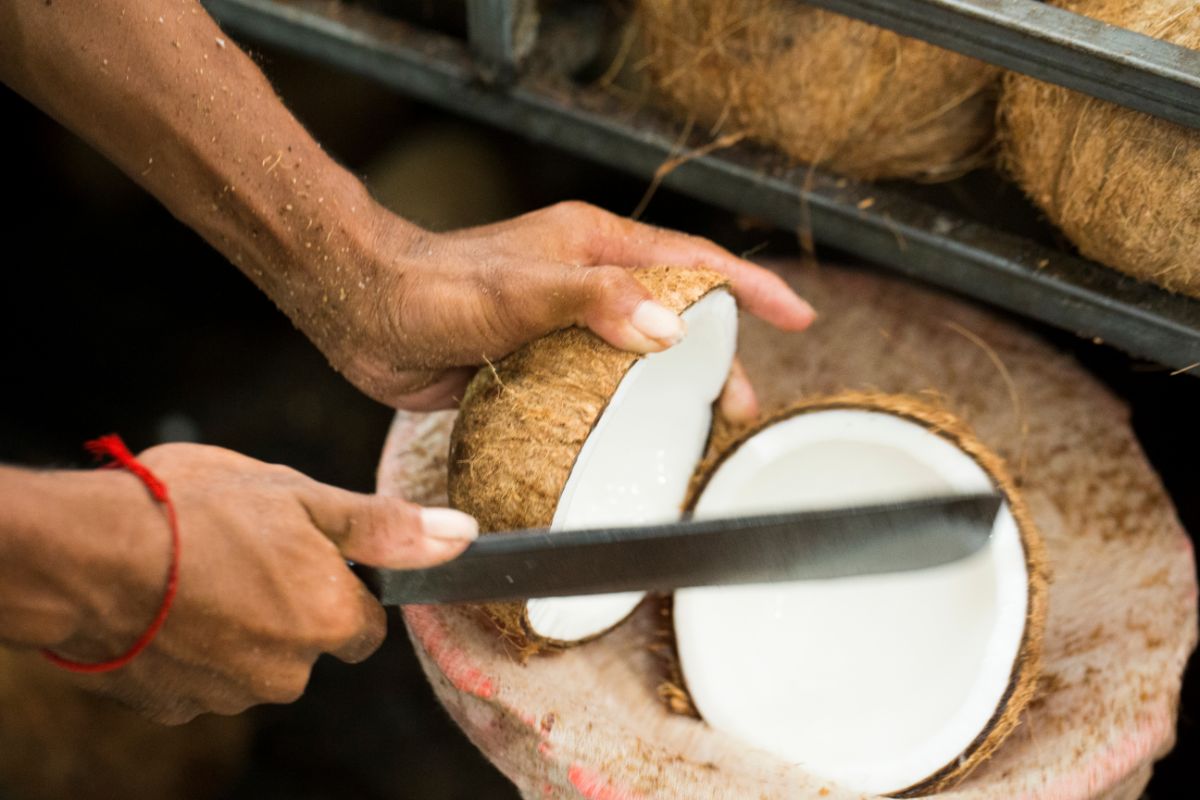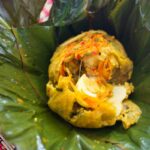With their hard outer shell and refreshing interior, coconuts offer a tropical delight that is both delicious and nutritious.
However, opening a coconut may seem like a daunting task for many. Fear not! In this article, we will guide you through the step-by-step process of opening a coconut, ensuring that you can enjoy its sweet water and flavorful flesh.

Coconuts are known for their versatility and have been a staple ingredient in many cuisines around the globe.
You might want to enjoy the coconut water, extract the flesh for recipes, or use the shell for decorative purposes. Whether you’re a curious culinary enthusiast or simply eager to savor the tropical goodness of a fresh coconut, join us as we dive into the art of opening a coconut.
Health Benefits Of Coconuts
Coconuts offer more than just tropical flavor; they also boast a wide range of health benefits. Here are some of the key reasons why incorporating coconuts into your diet can be advantageous for your well-being:
- Nutrient-rich: Coconuts are packed with essential nutrients. They are a good source of fiber, vitamins (such as vitamin C, E, B vitamins), and minerals (including potassium, magnesium, and copper). These nutrients play vital roles in supporting overall health and wellbeing.
- Hydration: Coconut water, the clear liquid found inside young coconuts, is a natural and refreshing electrolyte-rich beverage. It replenishes electrolytes in the body, making it an excellent choice for hydration, especially during physical activities or in hot climates.
- Heart Health: Although coconuts are high in saturated fat, they primarily consist of medium-chain triglycerides (MCTs). MCTs are easily metabolized by the body and are less likely to be stored as fat.
Studies suggest that MCTs may help improve cholesterol levels by increasing “good” HDL cholesterol and reducing “bad” LDL cholesterol, contributing to heart health.
- Weight Management: MCTs in coconuts can also promote satiety and support weight management efforts. They are believed to increase energy expenditure and enhance feelings of fullness, potentially reducing calorie intake.
- Digestive Health: The fiber content in coconuts supports healthy digestion and aids in preventing constipation. Consuming coconut products, such as coconut flesh or coconut flour, can contribute to a well-functioning digestive system.
- Antioxidant Properties: Coconuts contain antioxidants, such as phenolic compounds, which help protect the body against oxidative stress and reduce inflammation. Antioxidants play a crucial role in maintaining overall health and reducing the risk of chronic diseases.
- Skin and Hair Care: The natural oils present in coconuts have moisturizing and nourishing properties, making them popular ingredients in skincare and hair care products. Coconut oil can help hydrate the skin, improve hair strength, and even be used as a natural sunscreen.

How To Open A Coconut: Step By Step
Opening a coconut may seem challenging, but with the right technique, it can be a rewarding and enjoyable process. Follow these step-by-step instructions to open a coconut:
- Select a ripe coconut: Look for a coconut that feels heavy for its size and has no visible cracks. Shake it to ensure you can hear the sound of liquid inside, indicating it is fresh and full of coconut water.
- Locate the soft spots: A coconut has three indentations or “eyes” on one end. Two of these eyes will be softer than the others. One of the soft spots is the weakest point to penetrate the shell.
- Pierce the soft spots: Use a screwdriver, an ice pick, or a clean nail to puncture one of the soft spots. Gently tap the tool with a hammer until it penetrates the shell. Repeat the process for the second soft spot.
- Drain the coconut water: Hold the coconut over a bowl or container to catch the coconut water. Allow the water to drain completely by turning the coconut upside down and shaking it gently.
- Crack the coconut: Place the drained coconut on a towel or a hard surface. Hold it firmly with one hand and use a hammer or a mallet to strike the coconut along its circumference.
Rotate the coconut as you strike to create a line or crack around it. Continue tapping until the crack widens.
- Separate the coconut halves: Once a substantial crack has formed, use your hands or a sturdy knife to pry the coconut halves apart. Apply gentle pressure, and if necessary, use the knife to separate the flesh from the shell gradually.
- Remove the coconut flesh: Once the coconut is open, you can scoop out the flesh using a spoon, a coconut scraper, or a butter knife. Separate the flesh from the brown outer skin and discard any remaining shell fragments.
Coconut Culinary Uses
Coconuts are incredibly versatile and can be used in a wide range of culinary creations. Here are some popular culinary uses for coconuts:
- Coconut Water: The clear liquid found inside young coconuts, known as coconut water, is a refreshing and hydrating beverage. Enjoy it as a natural thirst quencher or use it as a base for smoothies, juices, or cocktails.
- Coconut Milk: Made by blending the grated flesh of mature coconuts with water, coconut milk is a creamy and flavorful ingredient used in various cuisines. It adds richness to curries, soups, sauces, and desserts, and is a popular alternative for those seeking dairy-free options.
- Coconut Oil: Extracted from the flesh of mature coconuts, coconut oil is a versatile cooking oil with a mild, nutty flavor. It has a high smoke point, making it suitable for frying, sautéing, baking, and as a replacement for butter or vegetable oils in recipes.
- Coconut Flakes/Shredded Coconut: Dried and grated coconut flesh, commonly known as coconut flakes or shredded coconut, is a popular ingredient in baking.
It adds texture and a hint of tropical sweetness to cakes, cookies, granola, and other desserts. It can also be used as a topping for salads, yogurt, or oatmeal.
Final Thoughts
Coconuts are a true culinary gem, offering a wide array of uses in the kitchen. From their refreshing water to their creamy milk, versatile oil, and various coconut-based products, coconuts bring a touch of tropical delight to countless dishes and beverages.
The unique flavor and texture of coconuts lend themselves well to both sweet and savory recipes, making them a popular choice in cuisines around the world.
Whether you’re adding coconut milk to curries, using coconut flakes to top baked goods, or incorporating coconut oil into your cooking, these delicious fruits offer a burst of tropical goodness that can elevate any dish.
- How To Reheat A Cheesesteak - November 5, 2023
- What Are Three Must Have Kitchen Knives? - September 22, 2023
- How To Protect Edges Of Pie Crust - June 15, 2023








